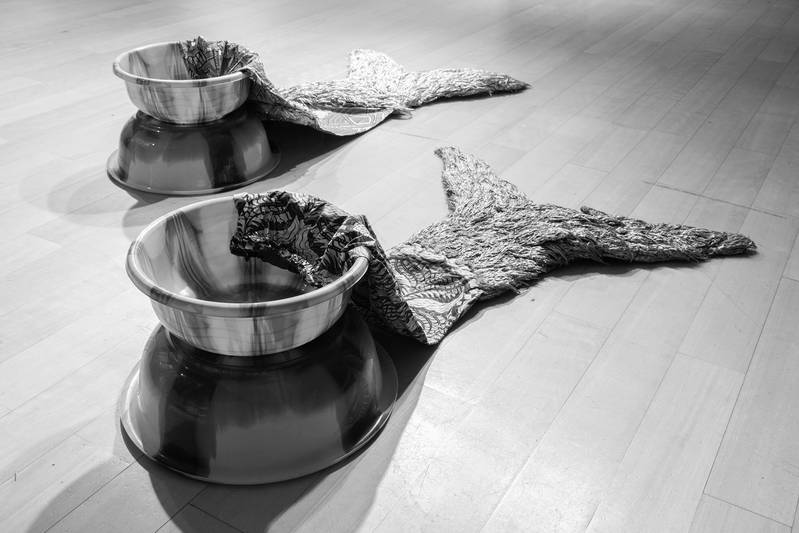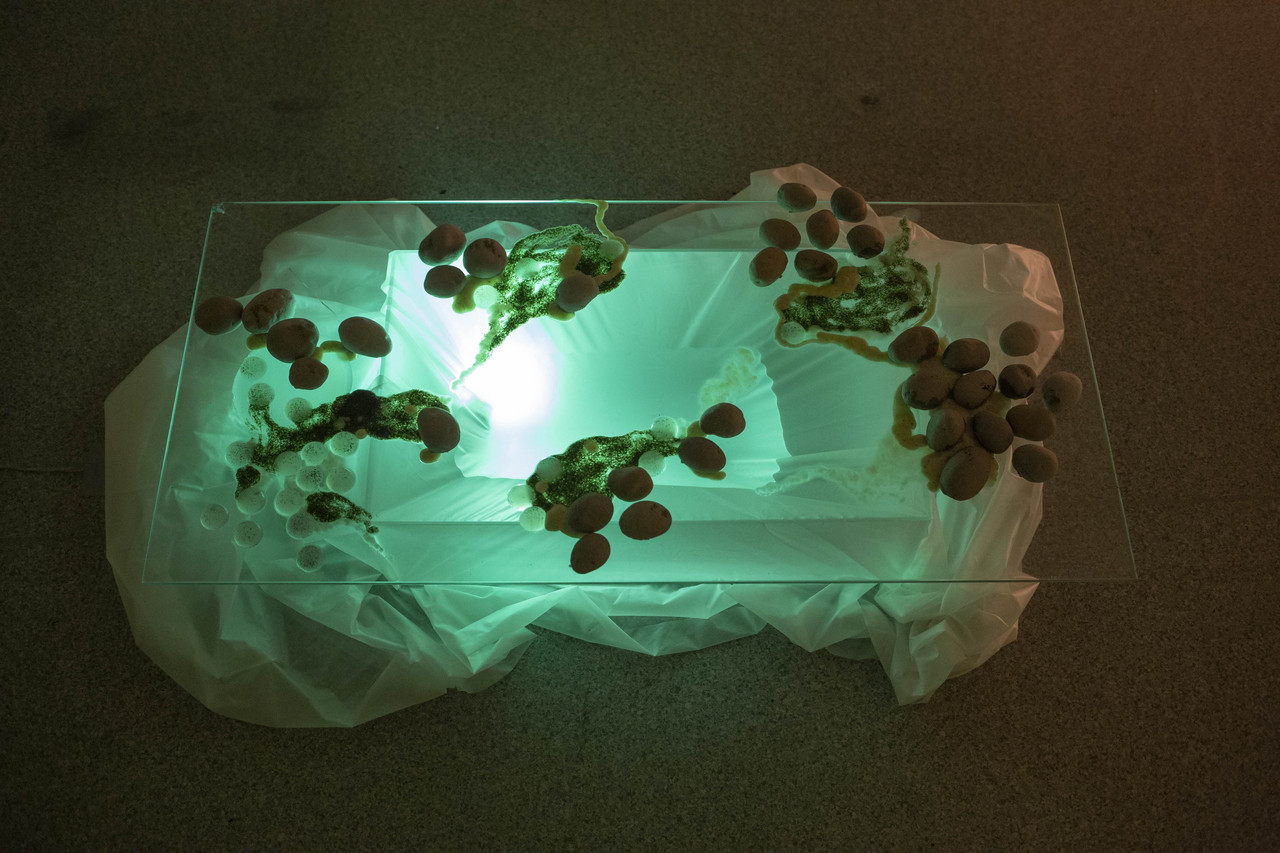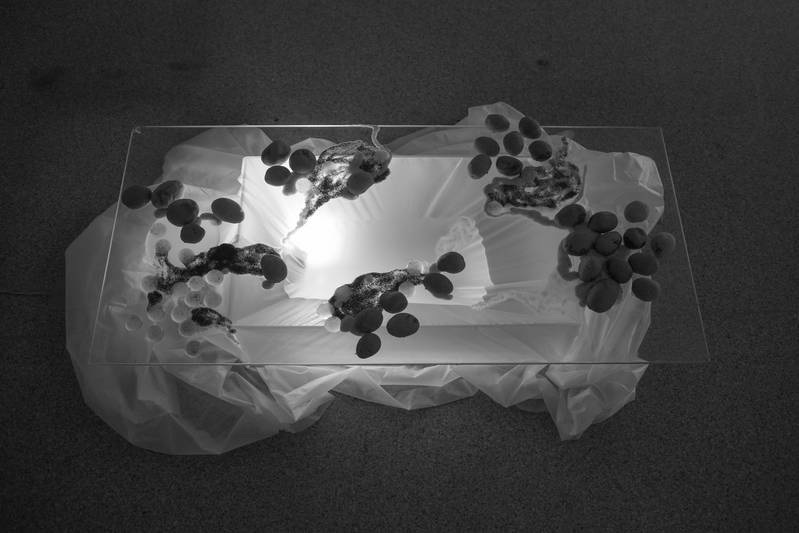Cultural Critique | MA | Curatorial Studies | News
Am 21. Januar 2024 luden die Künstlerin und Kuratorin Kandis Williams und Anselm Franke den renommierten Kulturhistoriker und Autor Klaus Theweleit, Autor von «Männerphantasien», zu einer öffentlichen Veranstaltung in Zusammenarbeit mit der gessnerallee Zürich ein. Ausgehend von einem gemeinsamen Seminar bestand diese Veranstaltung aus einer mittäglichen Filmvorführung mit Kommentaren und einem Abendvortrag von Klaus Theweleit, gefolgt von Beiträgen von Kandis Williams und Anselm Franke und einer gemeinsamen Diskussion.
Primal Images: Of Fascist Mythopoeia untersucht die mythologischen (Re-) sources des Faschismus in Vergangenheit und Gegenwart. Dass der historische Faschismus auf eine Vielzahl mythologischer Quellen zurückgreift, ist allgemein anerkannt. Weitaus weniger diskutiert wird, wie der wiederauflebende Faschismus heute die Psychologie kultureller Mythen und die «Urbilder» des männlichen Heldentums neu kodiert und wie sie mit der rassistischen Ordnung der Moderne Hand in Hand gehen und diese manifestieren.
Gessnerallee 8, CH-8001 mehr Informationen hier.
Am Donnerstag, 14. November feierten wir die Eröffnung der Ausstellung If you follow the river long enough.
Lautes Platschen, ein glucksendes Echo, spritzend, strudelnd, gleitend – eine Figur, die sowohl im Wasser als auch an Land verweilt, sich dazwischen bewegt, den Fluss bewacht und dich näher ruft, formverändernd, wild, und alles zugleich. In If you follow the river long enough mit Dietikon Projektraum möchten wir die gängigen Geschichten über Meerjungfrauen hinterfragen: Als verführerisch und damit gefährlich verurteilt, für die Wissenschaft verstümmelt, da ihr Aussehen nicht nur eines ist des Betrugs bezichtigt, als Gegenpol zu Reinheit und Tugend gebrandmarkt, in der Werbung objektiviert und sexualisiert. Wir folgen dieser Figur der Meerjungfrau, um hinter den glänzenden Vorhang der Macht zu blicken, die danach strebt, zu beherrschen und zu besitzen. Um die Akteure von Geschichten zu enthüllen, die sich die Erzählung der Kontrolle über (alle Arten von) Körpern zueigen machen.
Die Ausstellung präsentierte Arbeiten von Seba Calfuqueo, Lila-Zoé Krauß und Sohorab Rabbey und umfasste Filmvorführungen, Archivmaterial und eine Sammlung kultureller Referenzen.
Kuratiert von Angela Fusco, Mira Tyrina und Olga Popova. Mentoriert von Kim Anni Bassen, Paloma Ayala, Anselm Franke.
Diese Ausstellung ist ein Satellitenprojekt von ART FLOW, einer Initiative, bei der Künstler mit der Region Limmattal interagieren. Die Kunstwerke werden im öffentlichen Raum und in lokalen Institutionen wie dem Haus Regina in Dietikon in Zusammenarbeit mit dem Dietikon Projektraum ausgestellt und ermutigen die lokale Bevölkerung, das Limmattal neu zu entdecken. ART FLOW ist ein Beitrag zum Programm Regionale 2025.
For Zurich Art Weekend 2025, an innovative research-driven tour format has been developed in collaboration with the Zurich University of the Arts (ZHdK), under the direction of Prof. Dr. Anselm Franke and with the support of Kim Anni Bassen. These tours will lead audiences to unique and behind-the-scenes locations across Zurich, guided by emerging curators Isabel Piniella, Cristina Malerba, Maria Sorensen from ZHdK.
This initiative builds on a long-standing collaboration between Zurich Art Weekend and ZHdK’s MA Art Education, Curatorial Studies program (now MA Cultural Critique, Curatorial Studies), which began in 2018 and continues to foster art mediation practices and public education through guided tours.
'Art in Sacred Places: Then and Now. Zurich’s Revolutionaries'
Fri, June 13, 13:45 – 15:45 | EN
Sat, June 14, 13:45 – 15:45 | EN
The tour begins at the Main Police Station, featuring Augusto Giacometti’s impressive flower-covered ceiling, and continues through Zurich’s main churches, tracing the city’s history of Reformation. Along the way, discover Zurich-based revolutionaries, from Ulrich Zwingli, the fiery preacher and reformer at his modest home in Helferei, to Lenin’s exile on Spielgasse, just steps away from the Dadaists’ gatherings at the nearby Cabaret Voltaire.
The tour explores notable artworks within the churches, from Sigmar Polke to Harald Naegeli— Switzerland’s street art pioneer whose ‘Totentanz Cycle’ (Dance of Death) is still located inside the Grossmünster: after waiting almost a decade he had finally received permission in 2018 to paint it inside the church. Naegeli is the first Swiss artist who had to serve a prison sentence for his public artistic creations and at one point had to flee to Germany. At the Wasserkirche, where Zurich’s patron saints Felix and Regula were executed, visitors will witness a performance by Parzival, a contemporary artist dedicated to world peace since the 1970s. The tour concludes at the Predigerkirche, a peaceful refuge in the heart of the city, known for its impressive architecture and serene atmosphere.
Meeting point: Giacometti-Halle Amtshaus I, Bahnhofquai 3, 8001 Zürich
MARIA SORENSEN is an art curator, writer and a self confessed photography junkie. Using her background in film and visual arts, her curatorial practice deals with important societal issues using strong and expressive artistic language. Among her recent projects is an exhibition on state and self- censorship UnSaid, a theatre festival of Russian-language anti-war drama held at the Helferei and serving on a jury of Iranian Film Festival Zurich. Her writing on art and culture has been published by Kunstmuseum Bern, London-based Index on Censorship, Berlin-based On Curating and Zurich-based research initiative Ministry of Post-Collapse Art. Her photography will be a part of the Art Flow exhibition held in September. She holds a postgraduate degree in Curating and is currently doing MA in Cultural Critique at ZHdK, Zurich University of Arts.
'The Future Behind Us: Swiss Oil Experience'
Fri, June 13, 15:00 – 17:00 | EN
Sat, June 14, 10:30 – 12:30 | EN
Oil’s presence is invisible, yet it drenches everything around us. At a time when the future of oil is up for debate —amid promises of an energy transition, record levels of crude extraction, and robust profits for oil and gas companies— this archive tour examines the collision between early ecological concerns and the efforts of oil companies to shape socioeconomic narratives through cultural production. Focusing on Switzerland’s trente glorieuses period —from the postwar years to the 1973 oil crisis— the tour explores how oil was represented in visual culture to support the myth of progress. It centers on two key archival sources: a 1949 film by the Shell Film Unit and the 1956 exhibition Welt des Erdöls at Zurich’s Kunstgewerbemuseum, also sponsored by Shell. To ground these representations in their local context, the workshop also draws on the research and archival materials of the Schweizerisches Sozialarchiv, offering a socioeconomic and historical perspective. Together, these elements interweave history, culture, and energy politics through a distinctly Swiss lens.
Meeting point: Schweizerisches Sozialarchiv Stadelhoferstrasse 12, 8001 Zurich
ISABEL PINIELLA is a Swiss-based cultural analyst and postdoctoral researcher at the Institut d’Histoire du Temps Présent in Paris. She completed her doctoral studies at the Institute of History at the University of Bern, within the Global Studies Program. She holds both a bachelor's and a master’s degree from the Pompeu Fabra University and the Autonomous University of Barcelona, where she specialized in history, philosophy, and aesthetics. Currently enrolled in the Cultural Critique, Curatorial Studies program, she is driven by an interest in rereading history through artistic practices and the essay-exhibition format.
'The Captured Animal: Encounter at the ETH Bildarchiv Zürich'
Sat, June 14, 15:30 – 16:45 | EN
Sun, June 15, 12:15 – 13:30 | EN
How does photography capture, distort, or deny the animal?
This research tour offers a critically engaged journey through the ETH Zurich Image Archive, focusing on images that frame animals as companions, laborers, specimens, and objects of fascination. From portraits of domesticated creatures to staged taxidermy and scientific images, the selected materials expose historical ways of classifying, displaying, and disciplining the non-human. What traces of affection, violence, or curiosity linger in these images? Through close looking and collective discussion, participants will interrogate the politics of visibility embedded in archival practices—asking what is shown, what is omitted, and what remains unspeakable. This curated encounter invites reflection on the visual legacies that continue to shape how we see, represent, and relate to the non-human world today.
Meeting point: ETH Main Building, Rämistrasse 101, 8006 Zürich
CRISTINA MALERBA is a curator and art researcher. She is currently pursuing a postgraduate degree in Cultural Critique and Curatorial Studies at ZHdK, Zurich, after completing a BA in Visual Arts at NABA, Milan. She curated the group exhibition Pianerottolo in collaboration with the collective SPECIFIC at BiM, Milan. She has worked as an assistant at Galleria Martina Simeti and at Archivio Turi Simeti, where she contributed to exhibition-making and archival practices. Her curatorial interests focus on critical mediation and collective research, particularly within visual art history and archival contexts.
Im Symposium, das vom 1. bis zum 3. März 2024 an der ZHdK im Kino Toni stattfindet, interessieren wir uns für die Möglichkeiten und Grenzen des Zusammenlebens und des kollektiven Überlebens; für Sozialverträge, ihre Fundamente und ihre Brüchigkeit; und für die kollektive Konstruktion von Welt und Wirklichkeit vor dem Hintergrund divergierender Narrative. Ausgewählte Filme, die wir zusammen anschauen und diskutieren, dienen uns dabei als Denk- und Anschauungshilfen. Mit Diedrich Diederichsen und Teresa Koloma Beck als Gästen. Hosts: Anselm Franke, Ruedi Widmer und Studierende des Master Art Education.
Zur Vernissage von «Auf die Welt kommen. Geschichten des Widerstands» im Rahmen des Symposium
How are modern histories of violence written forth, and what cinematic-documentary strategies unravel and confront colonial amnesia and the nationalistic appropriation of collective traumas? The symposium Contested Memory in April 2023 took six films as the starting point for a discussion of narrative techniques and image politics in documentary film, which deal with memory and the afterlife and perpetuation of structural relations of violence. The films were discussed together with invited guests Jane Jin Kaisen, Volker Pantenburg and Students Master Art Education. The event was hosted by Anselm Franke at Kino Toni.
Wir freuen uns, dass Engadin Art Talks im Januar 2025 die vier Major Curatorial Studies Studierenden Kaëna Däppen, Julie Delnon, Lisa Maria Kocher und Olga Popova einlädt, die Kurator:innen, Guests und das Veranstaltungsteam zu unterstützen und wertvolle praktische Erfahrungen sowie ein tiefgehendes Verständnis des Programms zu gewinnen.
Engadin Art Talks / Form & Impact / 24.–26. Januar 2025 / Zuoz, Schweiz
Unter dem Thema Form & Impact untersucht E.A.T. die Möglichkeit, einen spürbaren Unterschied zu machen. Die eingeladenen Redner:innen und Teilnehmende kombinieren diese beiden Themen und tragen mit ihren Einsichten zur Gesellschaft bei.
Teilnehmende: Norman Foster (Architekt, UK), (LA) HORDE (Tanzkollektiv, FR), May Al-Ibrashy (Architektin, EGY), Sammy Baloji (Künstler, COD), Alvaro Barrington (Künstler, UK), Holly Herndon & Mat Dryhurst (Künstler, UK), Susan Hefuna (Künstlerin, CH/EGY), Rick Lowe (Künstler, USA), Siddhartha Mitter (Künstler, USA), Martina Voser (Landschaftsarchitektin, CH), YESHE (Singer-Songwriter, CH/TIBET).
Kurator:innen: Hans Ulrich Obrist (Künstlerischer Direktor, Serpentine Galleries, London), Daniel Baumann (Direktor, Kunsthalle Zürich), Koyo Kuoh (Direktor, Zeitz MOCAA, Kapstadt), Philip Ursprung (Professor für Kunstgeschichte und Architektur sowie Dekan der Fakultät für Architektur an der ETH Zürich).
Tickets gibt es hier.
Für Jahrhunderte war Rom das Ziel der klassischen Bildungsreise: als eine Reise zu den antiken Wurzeln westlicher Zivilisation, zu den Wurzeln des neuzeitlichen Abendlandes im Christentum und der Renaissance. Wie aber verändert sich unser Blick auf die Stadt und ihre Geschichte(n), wenn wir versuchen, ihre Mythologien aus feministischer Perspektive (gegen-)erzählen, oder die Rolle des Vatikans in der Kolonialgeschichte in den Blick nehmen? Mit Elisa Giuliano und Anselm Franke führte die MAE Studienreise in die Katakomben des Mithras-Kults, in die Vatikan-Museen, das Forum Romanum, zu einem Empfang der Feel Good Cooperative mit Pauline Curnier Jardin, zum Diana-Heiligtum am Lago di Nemi südlich von Rom, und ins Museum de la Civilita: stets dabei, die Wirkmacht vergangener Mythen in Kultur und Politik der Gegenwart zu reflektieren.









